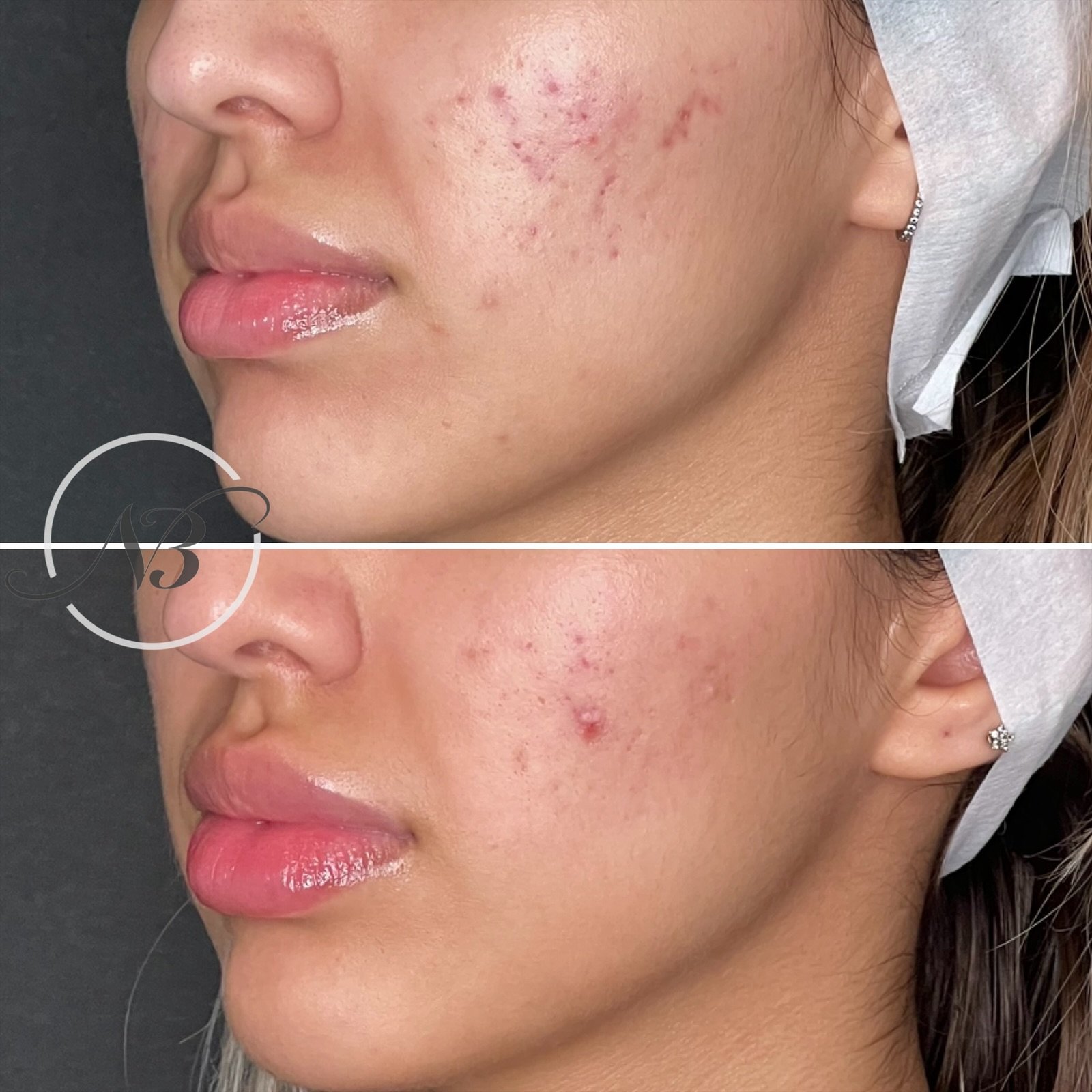
Microneedling
A naturally therapeutic path to timeless skin renewal.
Microneedling is a minimally invasive cosmetic procedure designed to rejuvenate the skin by stimulating collagen production and enhancing its overall texture and tone.
This procedure is versatile and can address a variety of skin concerns, including fine lines, wrinkles, acne scars, enlarged pores, and uneven skin texture. Results are gradual, with optimal improvements visible in the weeks following the treatment.
During microneedling, a device with fine, sterile needles creates controlled micro-injuries in the skin's surface. These microchannels trigger the body's natural healing response, promoting the production of collagen and elastin, essential proteins for maintaining youthful and resilient skin.
Two different solutions can be utilized to achieve results - Hyaluronic Acid Serum or Platelet Rich Plasma.
Microneedling
Platelet-Rich Plasma (PRP) serum is a skincare marvel derived from the patient's own blood. PRP is rich in growth factors, platelets, and healing proteins, making it a potent elixir for skin rejuvenation. In this serum, a small blood sample is processed to isolate the concentrated PRP, which is then applied topically to the skin. Known for its regenerative properties, PRP serum stimulates collagen production, accelerates tissue repair, and promotes a more youthful complexion.
Platelet-Rich Plasma (PRP)
Hyaluronic Acid
Hyaluronic acid serum is a skincare essential celebrated for its exceptional hydrating properties. Naturally present in the skin, hyaluronic acid is a moisture-retaining molecule that diminishes with age. In serum form, it acts as a powerful humectant, attracting and holding water to enhance skin hydration. Applied topically, hyaluronic acid serum helps plump the skin, reducing the appearance of fine lines and promoting a smoother, more youthful complexion.
-

A before and after of this patient after she was treated with 2 sessions of PRP Microneedling
-

2 sessions of PRP Microneedling
FAQs
-
Microneedling is effective for treating a variety of skin concerns, including:
Fine lines and wrinkles
Acne scars
Stretch marks
Enlarged pores
Uneven skin tone and texture
Hyperpigmentation
Loose or sagging skin
It can also help improve overall skin appearance and give you a smoother, healthier glow.
-
Yes, when performed by a trained professional, microneedling is safe. It’s a minimally invasive procedure with a low risk of complications. However, the risk of infection or scarring can be higher if aftercare instructions aren’t followed. It’s important to seek treatment from a licensed and experienced practitioner.
-
Most patients experience mild discomfort, but the pain is usually manageable. A topical numbing cream is applied to the skin before the procedure to minimize discomfort. Some people describe the sensation as a slight prickling or tingling feeling.
-
Immediately after treatment, your skin will likely be red and slightly swollen, similar to a mild sunburn. This typically fades within 24 to 48 hours. Some patients may experience light peeling or flaking in the following days, as the skin renews itself.
-
For most people, 3 to 6 sessions are recommended, spaced 4 to 6 weeks apart. This allows the skin to recover and produce new collagen between sessions. Maintenance treatments may be needed every 6 months to a year, depending on individual goals.
-
You may start to see some improvements in your skin within a few weeks, but the full effects typically take about 6 to 8 weeks to become visible, as collagen and elastin continue to rebuild. Improvements often continue for up to 6 months after the final treatment.
-
Yes, microneedling can be effective for all skin types, including sensitive and darker skin tones, as long as it's done correctly. It’s generally safe for most skin tones and types, but if you have active skin conditions like rosacea, eczema, or psoriasis, it’s best to consult with a dermatologist before proceeding.
Microneedling Packages
Revitalize, Rejuvenate, Reveal Your Radiance
Microneedling Pre & Post Care
Pre Treatment Instructions
Avoid Vitamin E, fish oils, and Ginkgo Biloba for one week prior to treatment.
Avoid Aspirin 2 weeks before treatment. (Please consult with your physician first if you are on Aspirin therapy).
Avoid anti-histamine and inflammatory drugs once week prior to treatment. These negate the effects of the procedure. The body's histamine and inflammatory responses are needed post procedure.
Stop Laser Hair Removal, Electrolysis, Waxing, and Depilatory creams one week prior to treatment.
Stop topical retinoids (tretinoin and retinoic acid (Retin-A, Renova, Refissa)) one week prior to treatment.
If using Accutane, a 3-month waiting period after discontinuation of medication is required.
Please notify our office if you have ever been diagnosed with Herpes Simplex Virus (HSV)- You may require prophylactic therapy.
Post Treatment Instructions
Avoid direct sun. This includes simple day-to-day tasks such as gardening, cooking over a hot stove for a long period of time, sitting next to a bonfire or fireplace, etc.
Discontinue use of any Alpha-Hydroxy products. You may resume your homecare regimen when skin is no longer flaking and peeling.
Use hydrating and reparative products. Products rich in soothing and healing ingredients are best to encourage new, healthy cell growth.
Use physical sunscreen. Sun care products should be applied no less than every 30-90 minutes. DO NOT go outside without sun protection (even on a cloudy day).





